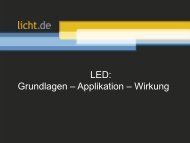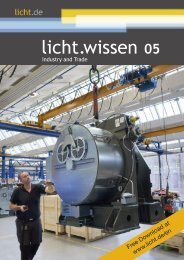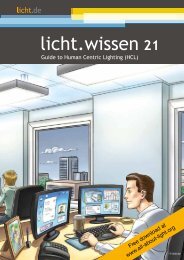licht.wissen No. 09 “Refurbishment in Trade, Commerce and Administration“
An extensive survey of offices, workshops and school classrooms shows that lots of lighting installations are obsolete. licht.wissen 09 informs that refurbishment sustainably lowers energy consumption, saves costs and makes for a significant improvement in lighting quality. This booklet from licht.de contains impartial advice for consultations with commercial clients. It also flags up web tools for assessing lighting installations and making design recommendations. Free Download at www.licht.de/en
An extensive survey of offices, workshops and school classrooms shows that lots of lighting installations are obsolete. licht.wissen 09 informs that refurbishment sustainably lowers energy consumption, saves costs and
makes for a significant improvement in lighting quality.
This booklet from licht.de contains impartial advice for consultations with commercial clients. It also flags up web tools for assessing lighting installations and making design recommendations. Free Download at www.licht.de/en
You also want an ePaper? Increase the reach of your titles
YUMPU automatically turns print PDFs into web optimized ePapers that Google loves.
Office lighting
From phoning to typing, to participating in team meetings – different activities performed in swift succession are a
typical feature of modern office life. Well-designed lighting ensures optimal conditions and an inspiring atmosphere.
Whether people work in a one-person, twoperson
or team office, their motivation and
performance increase significantly if they feel
comfortable in their working environment.
Lighting plays a crucial role here. It promotes
concentration and communication – and
makes an efficient contribution to greater
wellbeing at work. Lighting design takes account
of three dimensions of lighting quality.
Visual quality
The right light is vital for trouble-free vision;
it promotes visual performance and visual
comfort. As a general rule, the more
difficult the visual tasks, the higher the
illuminance should be. The illuminance at a
workplace should be at least 500 lux, for
demanding visual tasks at least 750 lux.
More light is permissible – and can make
for greater visual comfort for more than just
older employees. Supplementary task
luminaires provide scope for adjustment to
personal needs.
It is important to remember the need to
avoid interference from glare. Modern lighting
systems are helpful here, as are window
blinds that regulate daylight incidence.
Carefully positioned luminaires prevent annoying
reflections on screens and surfaces.
Emotional quality
Daylight and artificial light help shape our
response to architecture and indoor space.
In conjunction with electronic lighting management,
they make for an agreeable lighting
atmosphere, enhanced comfort and
significant energy savings. Integrated sensors
regulate the artificial lighting according
to the incident daylight available – and different
lighting scenes, which can be programmed
in advance, provide diversity.
Biological quality
Light synchronises human biorhythms and
has a considerable influence on our health
and performance. Modern lighting systems
recreate the dynamism of natural daylight
in the office. Illuminance levels and light
colours change gradually over the course of
the day – from stimulating cool white light
in the morning to dimmed warm white light
in the evening.
Concept
A combination of direct and indirect light is
recommended for general office lighting.
Also trending are luminaires with large plastic
enclosures that are evenly and efficiently
illuminated by LEDS.
More information on the subject is
provided in the booklets licht.wissen 04
“Office Lighting: Motivating and Efficient”
and licht.wissen 19 “Impact of Light on
Human Beings”.
Sample solution
3.85 m
5.40 m
Energysaving
77%
Old installation
New installation
Recessed specular louver luminaire* Recessed specular reflector luminaire with
with 4 x 18 W (T26) and LLB comp. LED, lighting control and presence detection
Number of luminaires 4 4
System wattage per luminaire 84 W 43 W
Effective operating hours / year** 2,750 1,238
Energy / year 924 kWh 213 kWh
Energy saving 77%
*Typical luminaire light output ratio approx. 68%. 4 x 1,350 lm x 68/100 = 3,672 lm
**The effective operating hours take account of need-based dimming as well as the activation/deactivation of lights due to presence and daylight detection and constant lighting control.
© licht.de
19
















